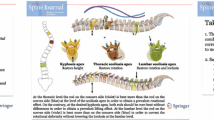Abstract
Purpose
To assess the efficacy and safety of a new deformity correction philosophy treatment for AIS called apical vertebral derotation and translation (AVDT).
Methods
It is a retrospective study of prospectively collected data concerning two different scoliosis correction techniques used in our department. A total of 81 patients (22M, 59F) with a mean age of 15.5 years and minimum follow-up of 2 years were reviewed. Patients were divided into two groups according to the correction technique: 36 patients underwent single-rod derotation using all screws construct (AS), while 45 patients underwent apical vertebral derotation and translation using screws and sublaminar bands (SB).
Results
The mean improvement of the MT curve was 70% in the AS group and 60.6% in the SB group, while the mean improvement of the TL/L curve was 65.5 and 72.4%, respectively. PT increased in both groups after surgery with a mean amount of 2.5° in the AS group and only 1° in the SB group. We observed also a greater amount of cervical lordosis reduction in the AS group (4.5°) compared with the SB group (only 1°). The SB group had less operative time and less blood loss.
Conclusion
There was no significant difference between the two groups at the final follow-up and both techniques led to an excellent correction in the frontal plane; in the sagittal plane, the AVDT technique seemed to give less sagittal imbalance with better cervical profile; the surgical procedure is easy with less operative time, less blood loss and less risk of potential complications.
Graphical abstract
These slides can be retrieved under Electronic Supplementary Material.





Similar content being viewed by others
References
Harrington PR (1962) Treatment of scoliosis. Correction and internal fixation by spine instrumentation. Am J Orthop 44-A:591–610
Luque ER (1982) Segmental spinal instrumentation for the correction of scoliosis. Clin Orthop Relat Res 163:192–198
Cotrel Y, Dubousset J (1985) New segmental posterior instrumentation of the spine. Orthop Trans 9:118
Suk SI, Lee CK, Min HJ et al (1994) Comparison of Cotrel-Dubousset pedicle screws and hooks in the treatment of idiopathic scoliosis. Int Orthop 18:341–346
Kim YJ, Lenke LG, Cho SK et al (2004) Comparative analysis of pedicle screw versus hook instrumentation in posterior spinal fusion of adolescent idiopathic scoliosis. Spine 29:2040–2048
Vora V, Crawford A, Babekhir N et al (2007) A pedicle screw construct gives an enhanced posterior correction of adolescent idiopathic scoliosis when compared with other constructs: myth or reality. Spine 32:1869–1874
Suk SI, Lee CK, Kim WJ et al (1995) Segmental pedicle screw fixation in the treatment of thoracic idiopathic scoliosis. Spine 20:1399–1405
Suk SI, Kim WJ, Kim JH et al (1999) Restoration of thoracic kyphosis in the hypokyphotic spine: a comparison between multiple-hook and segmental pedicle screw fixation in adolescent idiopathic scoliosis. J Spinal Disord 12:489–495
Sucato DJ, Agrawal S, O’Brien MF et al (2008) Restoration of thoracic kyphosis after operative treatment of adolescent idiopathic scoliosis: a multicenter comparison of three surgical approaches. Spine 33(24):2630–2636
Clement JL, Chau E, Kimkpe C et al (2008) Restoration of thoracic kyphosis by posterior instrumentation in adolescent idiopathic scoliosis, comparative radiographic analysis of two methods of reduction. Spine 33(14):1579–1587
Ilharreborde B, Even J, Lefevre Y et al (2010) Hybrid constructs for tridimensional correction of the thoracic spine in adolescent idiopathic scoliosis—a comparative analysis of universal clamps versus hooks. Spine 35(3):306–314
Jiang J, Qian B, Qiu Yong et al (2017) The azygos vein in at potential risk of injury from malpositioning of left thoracic pedicle screw in thoracic adolescent idiopathic scolosis patients. Spine 42(15):E920–E925
Bekki H, Harimaya K, Matsumoto Y et al (2016) The position of the aorta relative to the vertebrae in patients with Lenke type 1 adolescent idiopathic scoliosis. Spine 41(7):585–590
Author information
Authors and Affiliations
Corresponding author
Ethics declarations
Conflict of interest
The authors declare that they have no conflict of interest.
Electronic supplementary material
Below is the link to the electronic supplementary material.
Rights and permissions
About this article
Cite this article
La Maida, G.A., Peroni, D.R., Ferraro, M. et al. Apical vertebral derotation and translation (AVDT) for adolescent idiopathic scoliosis using screws and sublaminar bands: a safer concept for deformity correction. Eur Spine J 27 (Suppl 2), 157–164 (2018). https://doi.org/10.1007/s00586-018-5626-9
Received:
Accepted:
Published:
Issue Date:
DOI: https://doi.org/10.1007/s00586-018-5626-9




